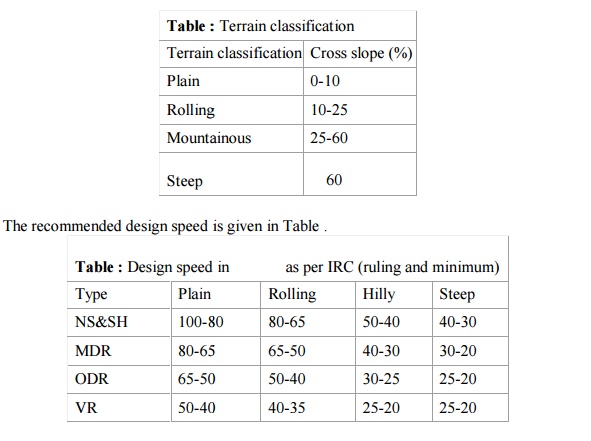Chapter: Civil : Highway Engineering : Geometric Design Of Highways
Geometric Design Speed of Highways
Design Speed
The design speed, as noted earlier, is the single
most important f actor in the design of horizontal alignment. The design speed
also depends on the type of the ro ad. For e.g, the design speed expected from
a National h ighway will be much higher than a village r oad, and hence the
curve geometry will vary significantly.
The design speed also de pends on the type of
terrain. A plain terrain can afford to have any geometry, but for the same
standard in a hilly terrain requires substantial cutt ing and filling implying
exorbitant costs as well as safety concern due to unstable slopes. Therefo re,
the design speed is normally reduced for terrains with steep slopes.
For
instance, Indian Roa d Congress
(IRC) has classified the terrai ns into
four categories, namely plain, rolling, mountaino us, and steep based on
the cross slope as given in table. Based on the type of road and type of
terrain the design speed varies. The IRC has suggested desirable or ruling
speed as well as minimum suggested design speed and is tabulated in table .
Table : Terrain classification

Terrain
classification Cross slope (%)
Plain 0-10
Rolling 10-25
Mounta inous 25-60
Steep 60
The recommended design speed is given in Table .
Table : Design speed in as per IRC (ruling and minimum)
Type Plain Rolling Hilly Steep
NS&SH 100-8 0 80-65 50-40 40-30
MDR 80-65 65-50 40-30 30-20
ODR 65-50 50-40 30-25 25-20
VR 50-40 40-35 25-20 25-20
1 Topography:
The next
important factor that
affects the geometric
design is the
topography. It is
easier to construct roads with required standards for a plain
terrain. However, for a given design speed, the construction cost increases
multiform with the gradient and the terrain. Therefore, geometric design
standards are different for different terrain to keep the cost of construction
and time of construction under control. This is characterized by sharper curves
and steeper gradients.
2 Other
factors :
In addition to design speed and topography, there
are various other factors that affect the geometric design and they are brie y
discussed below:
Vehicle: The dimensions, weight of the axle and operating
characteristics of a vehicle influence the design aspects such as width of the
pavement, radii of the curve, clearances, parking geometrics etc. A design
vehicle which has standard weight, dimensions and operating characteristics are
used to establish highway design controls to accommodate vehicles of a
designated type.
Human: The important human factors that influence geometric
design are the physical, mental and psychological characteristics of the driver
and pedestrians like the reaction time.
Traffic: It will be uneconomical to design the road for peak
traffic flow. Therefore a reasonable value of traffic volume is selected as the
design hourly volume which is determined from the various traffic data
collected. The geometric design is thus based on this design volume, capacity
etc.
Environmental: Factors like air pollution, noise pollution
etc. should be given due consideration in the geometric design of roads.
Economy: The design adopted should be economical as far as
possible. It should match with the funds allotted for capital cost and
maintenance cost.
Others: Geometric design should be such that the aesthetics of
the region is not affected.
Related Topics